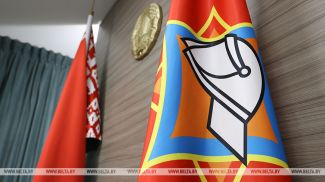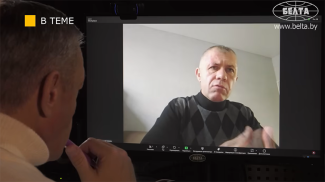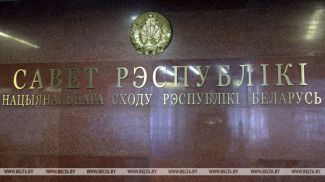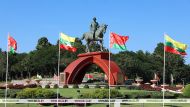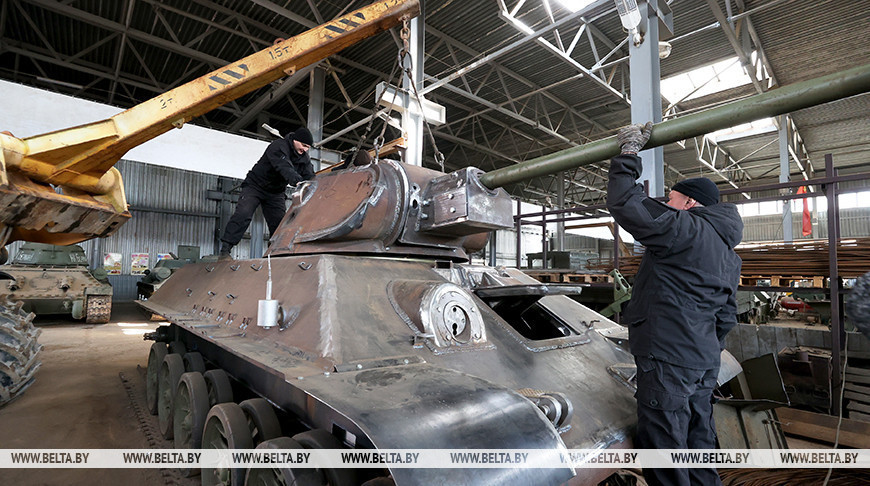
The Stalin’s Line Historical and Cultural Museum is working to restore a rare T-34-57 tank. The running replica of the legendary T-34 is based on the elements of three combat vehicles of the Great Patriotic War. BelTA correspondents had a chance to observe how the turret and gun were mounted on the hull of the combat vehicle.
Tank exterminator
There is hardly a Belarusian who has not heard of the legendary T-34. These tanks were nicknamed “the weapon of Victory” for a reason. They crushed the enemy in the Battle of Moscow, sealed the fate of the Battle of Stalingrad, and fought against the German Tigers and Panthers at the Kursk Bulge. Nowadays we see T-34s on the pedestals in honor of the liberation of Belarus from the Nazi invaders. However, not everyone knows that the most famous Soviet combat vehicle had a rare modification the T-34-57 called the “tank exterminator”.
In 1941, only ten T-34 tanks with a 57-mm gun were made. All of them took part in the famous 21st Tank Brigade’s assault on the city of Kalinin [present-day Tver]. The brigade commanders were Heroes of the Soviet Union Mikhail Lukin and Mikhail Agibalov. Four more vehicles were built in 1943. With the emergence of a more powerful 85-mm tank gun, the production of T-34s with a 57-mm gun was discontinued.
A running replica of this tank is now being built at the Stalin’s Line. According to the museum’s executive director Aleksandr Metla, the vehicle is based on the Soviet medium artillery tractor ATS-59. For the sake of historical authenticity, the restorers widened and lengthened its hull and made the elongated gap between the third and the second wheels, which was characteristic of the T-34.
“The tank we are making will have a 1940 hull and a 57-mm ZIS-2 gun. We are recreating the T-34 of the first editions. Such a hull was produced before the war. It had a different driver's hatch; the arrangement of triplexes was different too. The 'pie-shaped' turret was quite cramped, inconvenient for the crew but it was typical for vehicles of pre-war construction,” Aleksandr Metla said.
Why was the T-34-57 nicknamed the “tank exterminator”? It was because the 57-mm fired at a higher velocity than the 76-mm on conventional T-34 tanks resulting in better penetration and improved accuracy. The ZIS-2 gun was so effective that all German tanks were penetrated through on both sides, even diagonally. It is hard to even imagine its power since it was withdrawn from service with the wording “due to excessive armor penetration”!
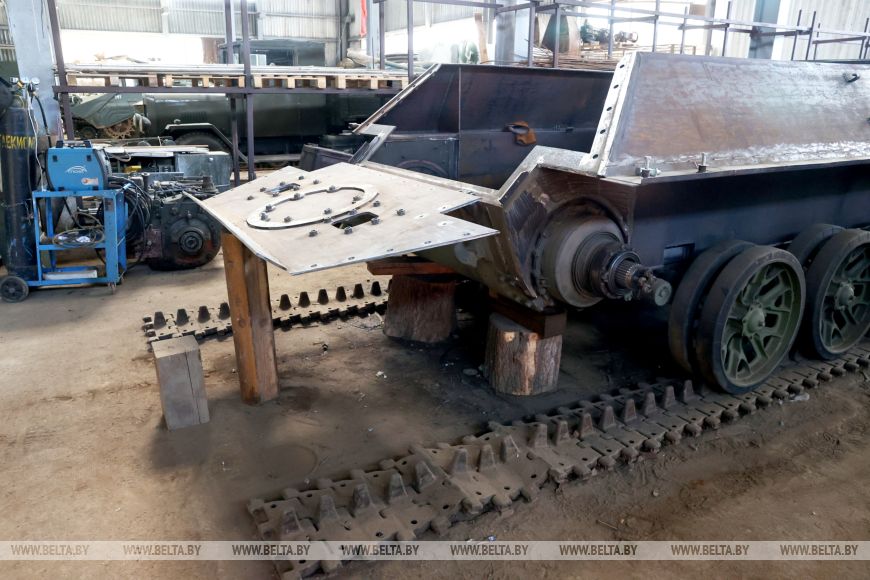
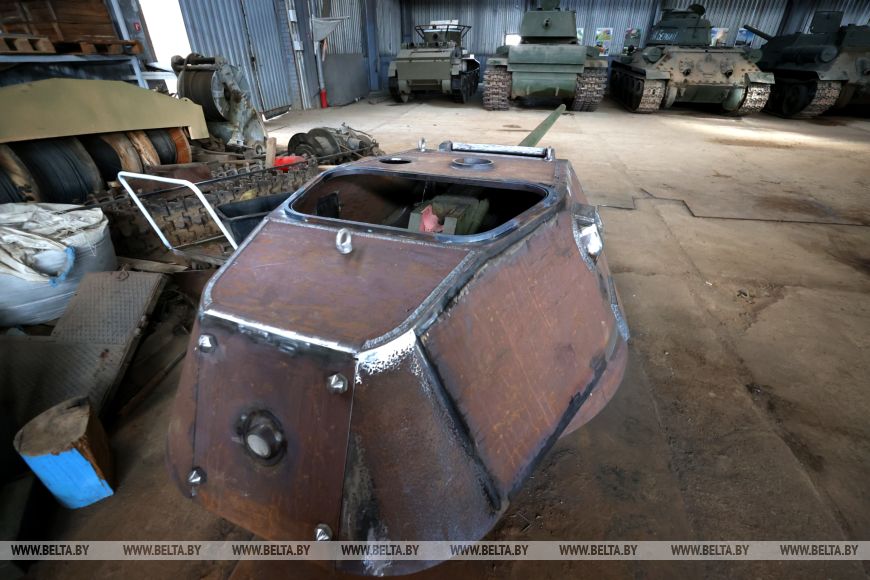
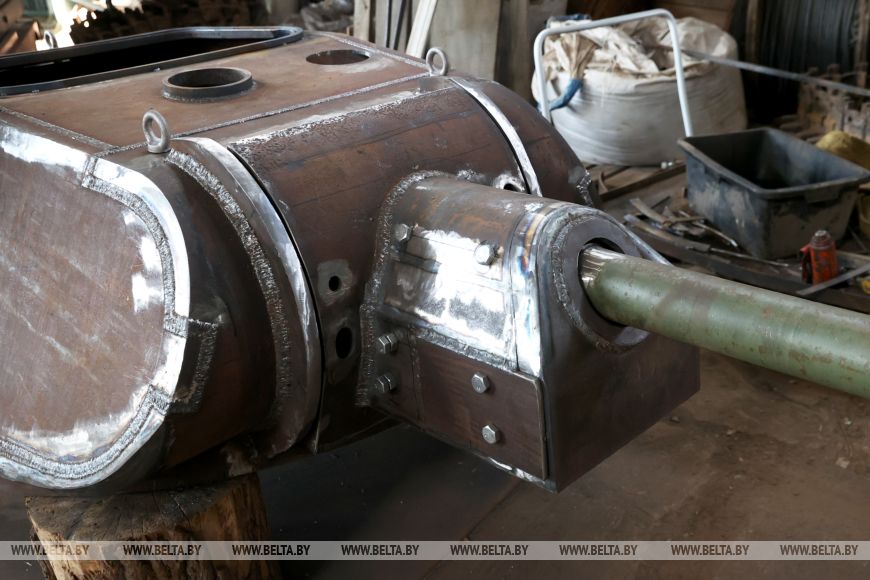
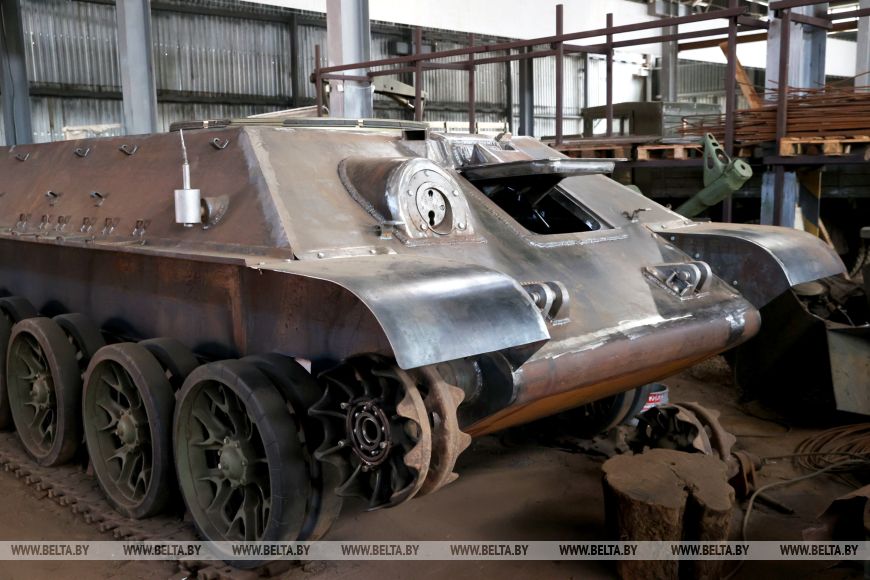
The work on the running replica of the T-34-57 began last August. The main task of the restorers is to make a functional wear-resistant vehicle to use it at Great Patriotic War reenactment shows. Thanks to the work of gunsmiths, it will be possible to see how the radio operator machine-gun works and even how the ZIS-2 fires.
“Since we find the remains of the vehicles, in theory we could make a tank with the original armor. However, the heavier the fighting vehicle is, the faster its box, friction and engine wear out. After all, we do not need to use this tank in battles. Our task is to show the beauty of the T-34 tank and do everything possible to make it last to please the audience as long as possible,” Aleksandr Metla explained. “We decided to make the armor similar to the original, but lighter. We also use more advanced post-war units and assemblies, including gearbox and cast-iron engine, because dural tank ones are very hard to operate in winter and it takes a long time to warm them up. The tank will have several original elements like, for example, a hatch cover, a radio operator turret, protection of exhaust pipes, and triplexes. The original tank weighed 32 tonnes. Ours will be about 20 tonnes heavy.
It is interesting how many original parts of the Great Patriotic War tanks have been used to make this running replica.
“Here you can see elements from three different tanks,” Aleksandr Metla said, pointing to the combat vehicle. “Two tanks were found near Grodno. One of them participated in the Zelva breakthrough [fighting during the crossing of the Zelvyanka River in June 1941]. The German photos show a downed T-34 on one of the roads. Most likely, it was blown up and dismantled for scrap metal, but some parts survived. Unfortunately, no information about the crew was found, as the first versions of these tanks had the serial number written in paint. Stamped serial numbers came into use much later. Parts of the third tank were found near Moscow, Russia.
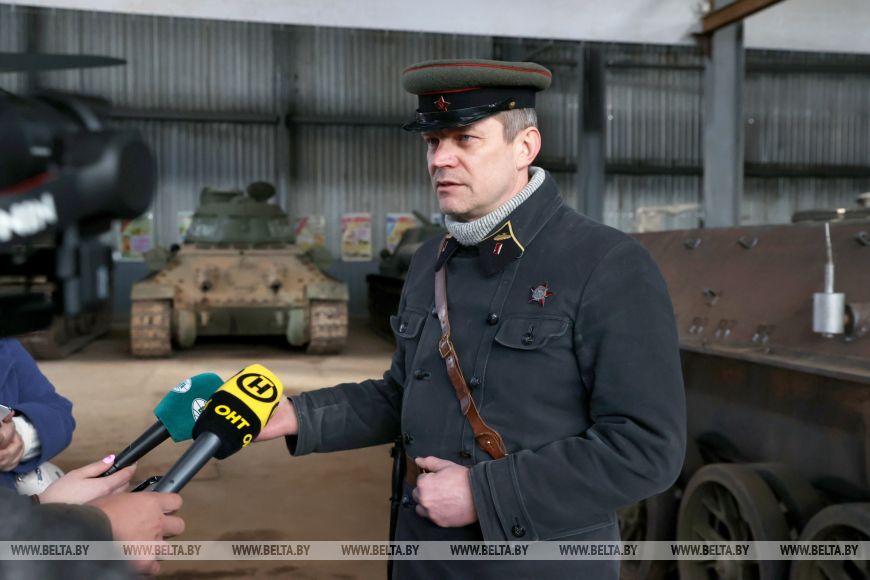
High-precision work
While we watch the turret and gun being mounted on the tank hull, I draw parallels between the work of the restorers and jewelers. Aleksandr Metla does not take issue with such a comparison: even though tanks are much bigger in size than jewelry, restorers really have to work with jeweler-like precision.
“Specialists of the defense industry company Uralvagonzavod named after Felix Dzerzhinsky came to the Stalin’s Line complex. When they saw our work, they were amazed that we could do such skilled operations on our own, without even having a design bureau. After all, we assemble parts according to drawings. Even though we do not mount original armor, we follow the same algorithms when assembling the equipment as modern defense industry companies do. Four restorers are constantly working on the tank. When help is needed in the manufacture of certain parts, they bring in gunsmiths, turn to factories or workshops.”
When asked if any of this four has the necessary qualifications, Aleksandr Metla answered smiling: “We have already made 21 units of equipment and an armored train. Do you think you will not become a professional when so many machines have passed through your hands?” the specialist asked. “If you are talking about military education, there are no former tankmen among us. These are ordinary guys, mostly graduates of Belarusian State Agricultural Academy, but they know their job well and love it very much.”
Aleksandr Mikalutsky, one of the four restorers working on the recreation of the T-34-57, is one of them. He has been restoring rare equipment for 25 years. Aleksandr Mikalutsky took to it thanks to a friend who invited him to help with the restoration of the BT-7 tank produced in 1935. This machine made its maiden ride in Russia in 2000 on the 80th anniversary of the tank building industry. Now it is hard to count how many units of equipment were brought back to life thanks to him and his colleagues.
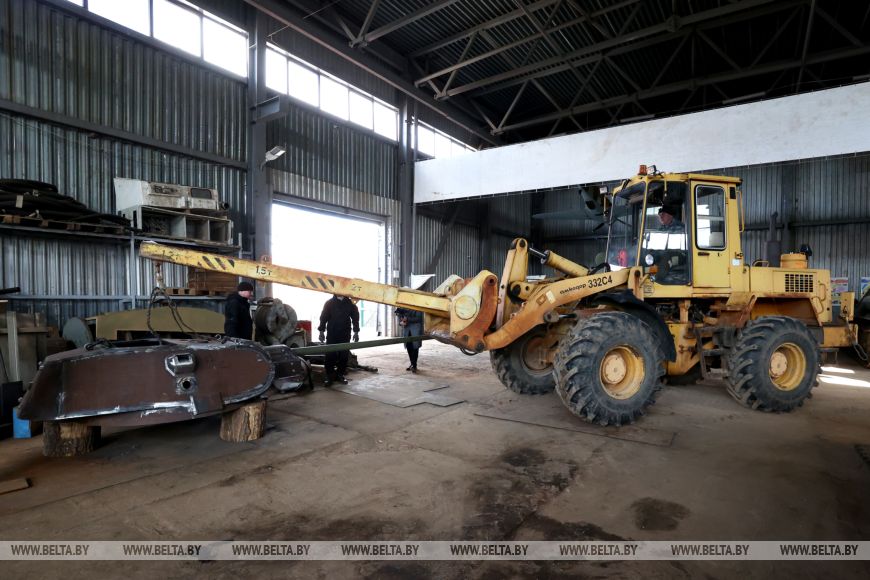
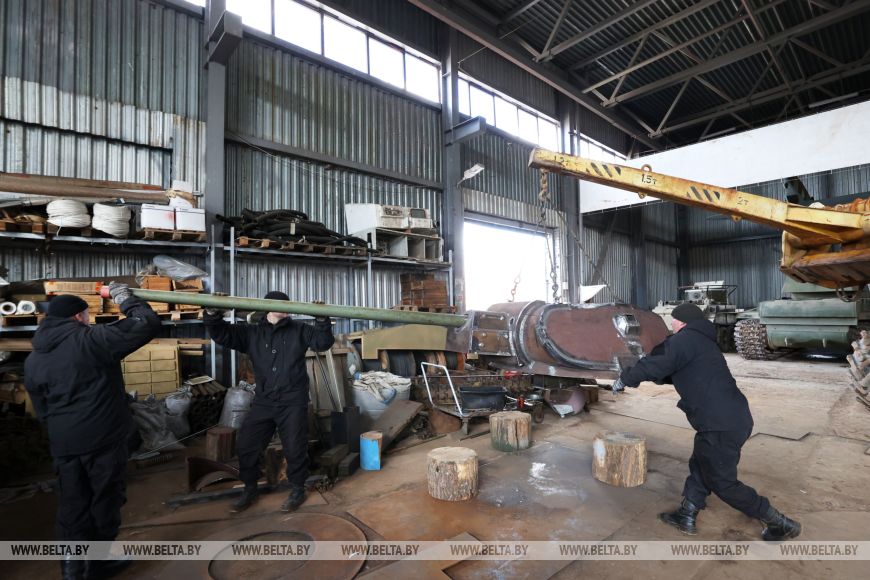
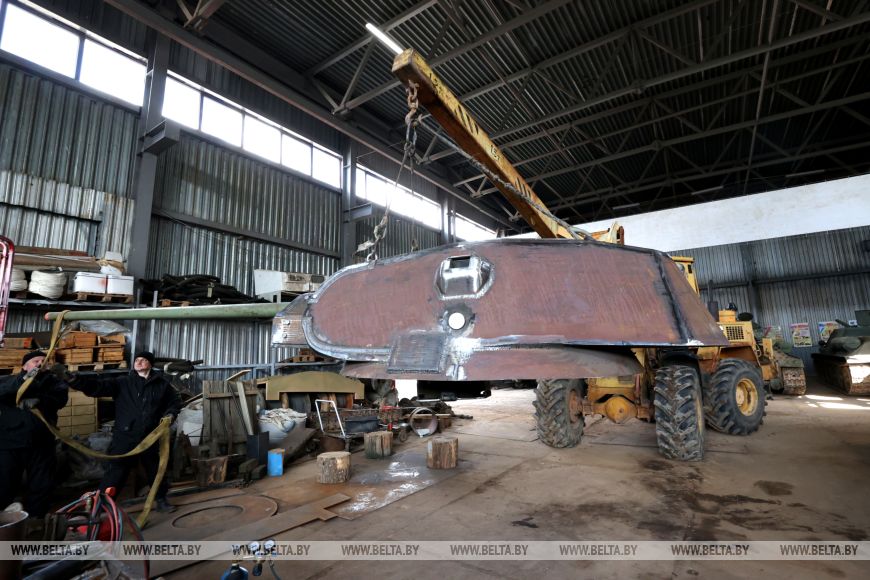
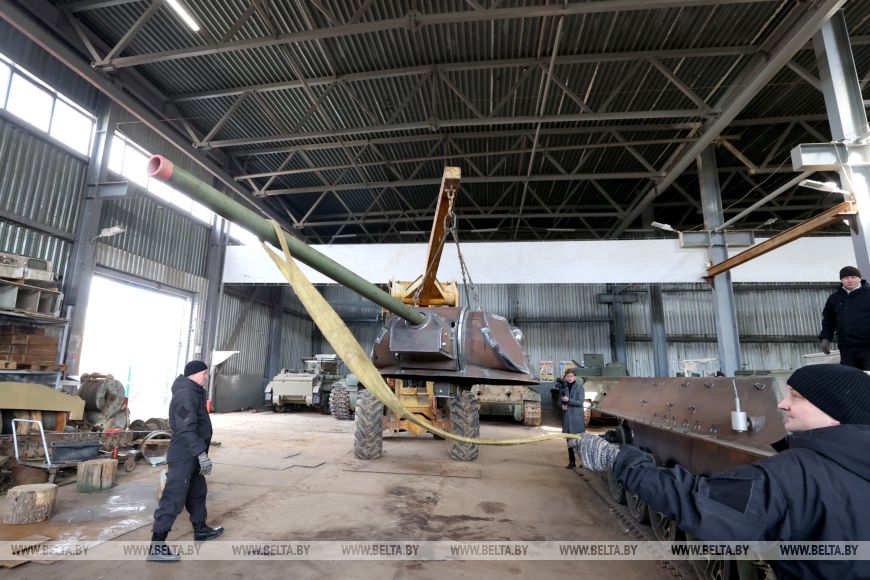

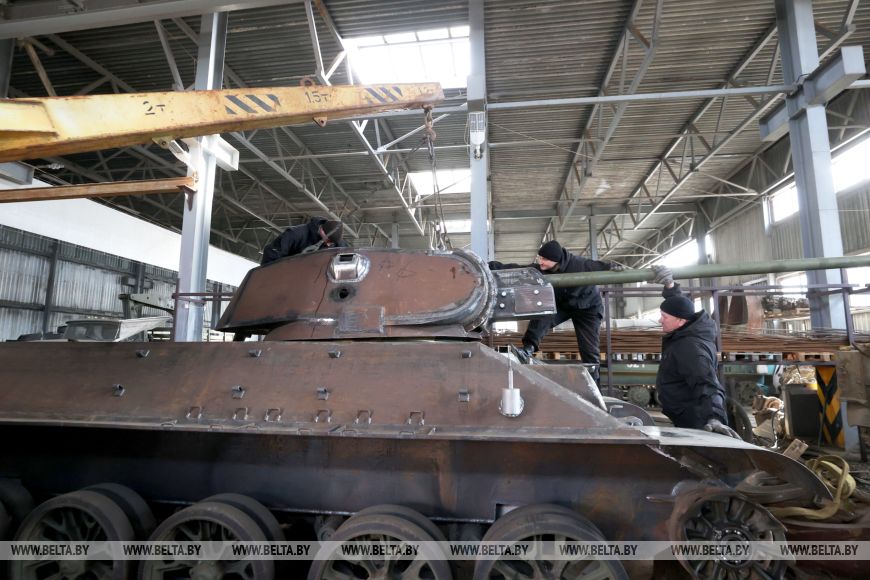







Tank exterminator
There is hardly a Belarusian who has not heard of the legendary T-34. These tanks were nicknamed “the weapon of Victory” for a reason. They crushed the enemy in the Battle of Moscow, sealed the fate of the Battle of Stalingrad, and fought against the German Tigers and Panthers at the Kursk Bulge. Nowadays we see T-34s on the pedestals in honor of the liberation of Belarus from the Nazi invaders. However, not everyone knows that the most famous Soviet combat vehicle had a rare modification the T-34-57 called the “tank exterminator”.
In 1941, only ten T-34 tanks with a 57-mm gun were made. All of them took part in the famous 21st Tank Brigade’s assault on the city of Kalinin [present-day Tver]. The brigade commanders were Heroes of the Soviet Union Mikhail Lukin and Mikhail Agibalov. Four more vehicles were built in 1943. With the emergence of a more powerful 85-mm tank gun, the production of T-34s with a 57-mm gun was discontinued.
A running replica of this tank is now being built at the Stalin’s Line. According to the museum’s executive director Aleksandr Metla, the vehicle is based on the Soviet medium artillery tractor ATS-59. For the sake of historical authenticity, the restorers widened and lengthened its hull and made the elongated gap between the third and the second wheels, which was characteristic of the T-34.
“The tank we are making will have a 1940 hull and a 57-mm ZIS-2 gun. We are recreating the T-34 of the first editions. Such a hull was produced before the war. It had a different driver's hatch; the arrangement of triplexes was different too. The 'pie-shaped' turret was quite cramped, inconvenient for the crew but it was typical for vehicles of pre-war construction,” Aleksandr Metla said.
Why was the T-34-57 nicknamed the “tank exterminator”? It was because the 57-mm fired at a higher velocity than the 76-mm on conventional T-34 tanks resulting in better penetration and improved accuracy. The ZIS-2 gun was so effective that all German tanks were penetrated through on both sides, even diagonally. It is hard to even imagine its power since it was withdrawn from service with the wording “due to excessive armor penetration”!




How the legend is made
The work on the running replica of the T-34-57 began last August. The main task of the restorers is to make a functional wear-resistant vehicle to use it at Great Patriotic War reenactment shows. Thanks to the work of gunsmiths, it will be possible to see how the radio operator machine-gun works and even how the ZIS-2 fires.
“Since we find the remains of the vehicles, in theory we could make a tank with the original armor. However, the heavier the fighting vehicle is, the faster its box, friction and engine wear out. After all, we do not need to use this tank in battles. Our task is to show the beauty of the T-34 tank and do everything possible to make it last to please the audience as long as possible,” Aleksandr Metla explained. “We decided to make the armor similar to the original, but lighter. We also use more advanced post-war units and assemblies, including gearbox and cast-iron engine, because dural tank ones are very hard to operate in winter and it takes a long time to warm them up. The tank will have several original elements like, for example, a hatch cover, a radio operator turret, protection of exhaust pipes, and triplexes. The original tank weighed 32 tonnes. Ours will be about 20 tonnes heavy.
It is interesting how many original parts of the Great Patriotic War tanks have been used to make this running replica.
“Here you can see elements from three different tanks,” Aleksandr Metla said, pointing to the combat vehicle. “Two tanks were found near Grodno. One of them participated in the Zelva breakthrough [fighting during the crossing of the Zelvyanka River in June 1941]. The German photos show a downed T-34 on one of the roads. Most likely, it was blown up and dismantled for scrap metal, but some parts survived. Unfortunately, no information about the crew was found, as the first versions of these tanks had the serial number written in paint. Stamped serial numbers came into use much later. Parts of the third tank were found near Moscow, Russia.

High-precision work
While we watch the turret and gun being mounted on the tank hull, I draw parallels between the work of the restorers and jewelers. Aleksandr Metla does not take issue with such a comparison: even though tanks are much bigger in size than jewelry, restorers really have to work with jeweler-like precision.
“Specialists of the defense industry company Uralvagonzavod named after Felix Dzerzhinsky came to the Stalin’s Line complex. When they saw our work, they were amazed that we could do such skilled operations on our own, without even having a design bureau. After all, we assemble parts according to drawings. Even though we do not mount original armor, we follow the same algorithms when assembling the equipment as modern defense industry companies do. Four restorers are constantly working on the tank. When help is needed in the manufacture of certain parts, they bring in gunsmiths, turn to factories or workshops.”
When asked if any of this four has the necessary qualifications, Aleksandr Metla answered smiling: “We have already made 21 units of equipment and an armored train. Do you think you will not become a professional when so many machines have passed through your hands?” the specialist asked. “If you are talking about military education, there are no former tankmen among us. These are ordinary guys, mostly graduates of Belarusian State Agricultural Academy, but they know their job well and love it very much.”
Aleksandr Mikalutsky, one of the four restorers working on the recreation of the T-34-57, is one of them. He has been restoring rare equipment for 25 years. Aleksandr Mikalutsky took to it thanks to a friend who invited him to help with the restoration of the BT-7 tank produced in 1935. This machine made its maiden ride in Russia in 2000 on the 80th anniversary of the tank building industry. Now it is hard to count how many units of equipment were brought back to life thanks to him and his colleagues.
“Everything that you now see in this hangar on Stalin’s Line was made by our team. At first, it was a hobby. But very quickly it grew into a profession. Now we look completely differently at any machine that we begin to make. We approach it with soul and responsibility, we preserve historical authenticity. We want people to remember what happened during the Great Patriotic War, in which the entire Soviet Union participated, to remember the price paid for the Great Victory,” says Aleksandr Mikalutsky.
“One of the main tasks for the restorers is to make the machine as authentic as possible, so it looks exactly as it did when it was operational. This way, during any reenactment, spectators will be able to see what happened 80 years ago.






The restoration team at Stalin’s Line has been working together for years. Initially, only Aleksandr Mikalutsky and Vladimir Yakushev, both natives of Shklov, were involved in working on military equipment. Later, Vladimir Yakushev's sons Aleksei and Maksim joined them.
When asked about the challenges the team faces while restoring a tank, Aleksandr Mikalutsky smiled and said: “We do not face any challenges in our work. Sometimes we lack suitable parts, but we resolve these issues promptly. For example, we search for them online or try to recreate them ourselves. However, there are elements we cannot manufacture here. In such cases, we order them from facilities equipped with specialized lasers and other necessary tools.”

Aleksandr Mikalutsky and his colleagues not only restore equipment but also participate in the retrieval of machinery of the Great Patriotic War period. “During the last excavation we attended the STZ-5 artillery tractor was found. It is a rare machine, the only one in Belarus. We restored it last year, made it operational and now it takes part in reenactments,” he said.
Usually, specialists unearth only individual parts of equipment from the Great Patriotic War period. But sometimes almost complete tanks or airplanes are pulled from swamps. Such discoveries are sensational for our time.
“For example, we discovered an intact BT-7 tank. Another tank we found, which was about 60-70% preserved, was a German StuG III self-propelled gun,” Aleksandr Mikalutsky stated. “When we excavated a crashed plane, we found personal belongings of the pilot. In his inner pocket, he kept a letter from his wife and a small piece of printed fabric. Unfortunately, the paper was poorly preserved, but we managed to decipher a few sentences. The woman wrote that their son was growing up and that they were looking forward to seeing him again. We also found some rubles and route sheets that the pilot carried with him. These kinds of discoveries are deeply moving. At such moments we realize the value of our work. Of course, it is not always possible to identify who was operating the tank or sitting in the cockpit of the downed plane, but we do our utmost to figure it out. As they say, our work won’t be finished until the last fallen soldier is found.”


Moving to Stalin’s Line
The engine compartment of the T-34-57 tank has already been assembled. The tank body will soon be moved into the paint shop. If everything goes according to plan, the famous “tank destroyer” will move to Stalin’s Line this year ahead of the 20th anniversary of the historical and cultural complex.
For now fans of military hardware can see other tanks in action. On 12 April Stalin’s Line will host a reenactment of the Berlin offensive operation. It lasted for a total of 17 days (from 16 April through 2 May 1945) but in that period the Red Army captured Berlin and the entire leadership of Nazi Germany. All units of the Wehrmacht, SS troops, and Volkssturm, who had been defending the city, were eliminated or surrendered in the capital of the Third Reich on 2 May. An unconditional surrender was signed late in the evening on 8 May 1945.
“We will try to demonstrate the nature of those battles and the role of armored crewmen in fighting for Berlin. After that our active service soldiers, who drive modern T-72 tanks, will demonstrate their skills. They will demonstrate how weapon systems work and how the tanks force various obstacles,” the executive director of the historical and cultural complex Stalin’s Line noted. “During such reenactments we try to demonstrate the role of the Soviet nation, the USSR leadership and particularly the homefront in achieving the victory. After all, without the homefront, without the production of hardware it would have been impossible to achieve it. It was the relocated enterprises, including Belarusian ones, that made 85% of the weaponry. They played a particularly important role in the first heaviest years of the war. They made tanks, upgraded them. They made aviation systems, communications systems, small arms, and provided fighters with food. The genius of our tank manufacturing industry, of our weapon designers – we will demonstrate all of it during the reenactment. Well, of course, we will endeavor to present the nature of the fighting, the cruelty of the enemy, the unbelievable losses, and the heroism of the Soviet fighters as much as possible.”









